**INITIAL DISCLAIMERS**
Spoilers abound in this review. Duh.
Fair warning: if the two newest Star Wars movies are a source of inspiration and hope to you, don’t let me be a rainy hater on your parade. You keep hoping and being inspired. But do at least hear out and consider my comments about the integrity of art and the weird relationship I’m seeing between truth-telling narratives and consumerism.
We covered in my Force Awakens review how I cried in the theater AND the shower about Han Solo’s untimely demise. I’m still crying over him, apparently, because I lost my ever-loving mind during The Last Jedi. When Luke walked into the Millenium Falcon cockpit and switched on the lights, I got seriously watery-eyed.
Then R2 played Leia’s “Help me, Obi-Wan Kenobi” hologram, and I was gone. We’re talking take-off-your-glasses-so-you-can-mop-your-face-because-you-can’t-see kind of gone. I am 100% sure the row in front of me heard my sobs.
The funny thing is, I couldn’t say why I was crying. Because Han was gone? Because I’m so frustrated at how they’ve treated the original characters? Because I treasure the Original Trilogy (OT) story, and it was a slap to see new writers imagine such tragic outcomes for it?
All those things were true.
But this also was true: I was crying because I just love the originals so damn much.
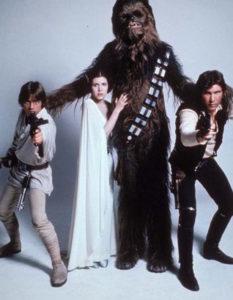 FIGHT WHAT YOU HATE, OR SAVE WHAT YOU LOVE?
FIGHT WHAT YOU HATE, OR SAVE WHAT YOU LOVE?
That brief sequence in TLJ channeled a nostalgic shockwave that, for an instant, put me back into my theater seat in 1997, a kid watching A New Hope for the first time. Only now, I’m a mid-30s woman with the perspective to understand the impact the Original Trilogy (OT) had on my life. The strength of that moment could only be expressed in tears.
(This is what happens to storytellers, by the way. We get spiritual about movies and people look at us like maybe we forgot our meds today.)
At the end of TLJ, Rose wisely states that we don’t win by fighting what we hate, but by saving what we love. I think that’s what happened to me. I was forced to remember what I love instead of obsessing over what I disagree with.
It’s no secret that I have disagreed with many things about this new trilogy, and, I believe, rightly so. But there’s a fine line between protecting what you love and attacking what you hate, and I haven’t always stayed on the correct side of that line.
So let me start this review by explaining what I love, and maybe it’ll keep me honest.
- I love stories that give hope and tell truth.
- I love the craft of good storytelling.
- I love me some Star Wars Original Trilogy.
And because I love good storytelling, honest evaluation of story quality is very important to me. Like it or not, our culture uses visual narrative to inform our worldview, so if we lose our ability to critically reflect on the quality of those narratives and their messages, we get a bit lost. Our souls suffer. Famine sweeps the land and ominous thunder crashes, etc.
With all that said, what the heck did the Observational Ginger make of The Last Jedi?
GOOD NEWS
Many things in this film were cool!
To be honest, everything good about it also applies to my review of TFA. The female Jedi, the soundtrack, the humor, the visuals, the editing, the new settings, the diversity, the fact that the writing is better than Attack of the Clones.
I don’t mean to be a Scrooge by cutting down the “good” part of my review, but I truly will just reinvent the wheel if I write it all down. Go read my TFA post, apply it to this film, and then add these four things:
- Space Mom Leia. If we got nothing else from this film, we got that scene where Leia Force-pulls herself back into the damaged ship. It was the culmination of her character’s Jedi potential and bad-assery.
- Animals. I know everyone complained about the Ewoks from the OT, but I always liked them, and this film delivered the same type of space cuteness! It was nice to see guinea-penguins, and those nude cliff-dwelling milk cows, and the frosty little foxes! Especially after the giant iguanas and gassy hairless elephant camels in the prequels, the ones you wanted to see eaten by predators.
- Red throne room guards from Return of the Jedi. I don’t know why, but I was irrationally delighted to see them again. They fascinate me with their unconventional career choice: perpetually in cahoots with whatever bad guy is on the throne at the moment. Who are they? Why did they choose this life?
- The hopeful theme. Being a sort of sci-fantay fairy tale, Star Wars has always traded in hope, and I tip my hat to that. I understand why so many found this film moving for that reason
BAD NEWS
Overall, however, I’m concerned. I’m concerned from an artistic perspective about all the critical praise this movie received. It baffles me, honestly. The movie wasn’t bad, but it also wasn’t nearly as great as internet reactions say it was—particularly in the areas of writing and plot.
(Please, please don’t kill me! Please? Just hear me out.)
It was unfocused.
They tried to cram way too much into this film, and sadly, a lot of good elements suffered for it.
- Too many characters. They introduced people who didn’t need to be there and took needed screen time away from the main protagonists. Poe and Finn felt unexplored and flat by the end, and no wonder. They spent their time reacting to unfamiliar people with no chance to bounce off of their established relationships with each other and Rey. Leia was sent to sleep for the middle of the movie so Laura Dern could come out and play Leia’s role for a while, and then they switched places again when Laura Dern died, and I’m still not sure why there had to be two of them. This felt like an ensemble film rather than a Star Wars film.
- Muddled Plot: Ideally, a plot unfolds so organically that it doesn’t feel written. Rather, it feels like an inevitable unfolding of cause-and-effect that could not play out any other way. Good examples include Interstellar and the latter half of Star Trek: Into Darkness. In TLJ, Finn and Poe’s side of the story could have been written any other way and still led them to that end scene. Rey’s decisions and choices were the only thing truly driving the story, making a full half of the film feel like filler. (Really. Can you explain to me why the casino had to be part of the story, or the traitor thief in the dungeon, or Rose and Finn’s entire relationship, for that matter?)
- So. Many. Themes. Exploitation of the poor. Moral ambiguity of financing war. Fight what you hate vs. save what you love. Let old things die. Regret/failure/giving up. You don’t need a special background to be special. You already have everything you need. Disappointment in a mentor. People are never really gone. I loved and agreed with each theme individually. But again, they crowded each other until none had room to be properly explored. Seriously movie… pick one.
It was derivative.
I’ve read several reviews praising this film for its originality and subversiveness. They say it struck bold new territory and managed to defy expectations. I think that’s true when compared to TFA, which mirrored A New Hope too closely. But that’s a low bar for originality comparison.
The outline of TLJ’s plot points didn’t unfold in the same order as Empire, but tons of plot elements, themes, and even details were pulled directly from all of the previous 3 Star Wars movies, and even some from the prequels. Now, is it wrong to reuse plot points and themes? No. Some Star Wars elements absolutely should be reused. But it’s the amount of derivation in this film that’s problematic, and reviewers’ inability to discern the difference between creating original art vs. pleasing fans with a franchise formula.
- At start of movie, rebels get chased from their base and a small group of characters are pursued (without the ability to escape via hyperspace) by a much larger force of star destroyers.
- Later, turning the ship around and running directly at the Star Destroyer.
- At start of movie, the baddies are huge and powerful and the rebels are under-equipped (even though that doesn’t make sense in this trilogy, because in TFA the baddies were just a fringe group getting started and had their biggest asset blown up at the close of the movie).
- Ship gets away, much to a bad man’s chagrin, and immediately someone says the boss is calling for an update on progress.
- Hologram boss chokes the bad man who let the ship get away.
- 3 original main characters split up for the second trilogy installment.
- Mentor from previous movie is dead when film begins and untrained Jedi must find new mentor to train under.
- Going to a deserted land full of critters to find that Jedi master, who lives in a dome-shaped house.
- The Jedi master is there following very sad events that involved another Jedi turning to the dark side and killing people.
- The idea that the Jedi are almost extinct, but had been thriving until someone killed them.
- The master is not what the main character expected, and the two don’t always get along.
- The master initially resists training the new Jedi.
- Jedi training, when protagonist discovers they don’t know as much about The Force as they thought they did.
- One area of the master’s home is a scary dark place.
- Scary dark place contains a vision you need to see that reveals something about yourself, when you were actually expecting it to reveal something about your parents (Luke did not yet know Vader was his parent at that point, but the parallel holds, I think).
- Yoda teaches Luke something important while also telling Luke to get over himself.
- Going back to save someone from the dark side when a mentor tells you it can’t be done.
- A twist when your mentor has withheld the whole truth about the baddie’s backstory.
- A reveal (from the bad guy) about your origins (this time it’s that your origins aren’t significant, last time it was that your origins are significant).
- The reveal of your origins causes an identity crisis which the bad guy tries to use as leverage to get you to join him in a moment of weakness.
- Going to a town that is a space caricature of a certain type of skeezy establishment (this time it’s a casino instead of a cantina).
- You find a rogue-ish person at this establishment (only this time he’s bad instead of good).
- Being thrown into a prison cell with other prisoner neighbors and finding someone in your cell (okay, this one barely counts as Star Wars derivation because it’s been done in so many other movies, but the dungeon of ROTJ was the first thing I thought of when I saw the visuals of the jail that Finn and Rose get put into).
- Sneaking on an enemy ship to affect one piece of equipment that will help other friendly ships (almost every Star Wars movie ever made including Rogue One).
- Someone you thought was helping you actually turns you over to the bad guys (Lando, anyone?).
- Allowing yourself to be captured by the main baddie and taken to see the uber-baddie in handcuffs, hoping the situation will pressure the baddie into realizing that he doesn’t want to kill you or be evil anymore.
- Throne room scene where protagonist faces down the big baddie and his apprentice, and is tempted to go to the dark side.
- Big baddie is probably human but looks like some kind of monster and uses the Force.
- In throne room, bad guy has dudes in red who are in cahoots with him and act as guards.
- Baddie is after Luke Skywalker because Luke is super powerful.
- In throne room, the reveal to protagonist that the entire Rebel fleet is about to be destroyed. Because…
- Rebel ships thought they’re safe and protected, but in a twist, baddies actually have the ability to destroy them after all.
- In throne room, the reveal to the protagonist that the bad guy knew about something the entire time and allowed it to happen (in this case it was the mind connection between the good guy and bad guy rather than knowing about rebel alliance plans).
- Baddie changes mind about killing protagonists, offs the bigger, badd-er baddie.
- Reaching hand out and saying “join me.”
- Moral ambiguity of whether bad guy has 100% bad motives or whether he sees himself as holding power so he can set up his own rule the “right” way.
- Showdown between protagonist and major baddie ends with protagonist escaping and baddie being disappointed.
- Snow planet battle with walking things and Rebel fighters in small ships running at them.
- A big door on the snow planet that closes the Rebel fleet off from the outside.
- Luke, Leia display a psychic connection toward the end of the second movie after not displaying it in the first movie.
- The mentor who trained you dies.
- Ends with a lot of elements not tied up yet but the hope that they will go on to fix what’s still broken.
AND FINALLY: - A second-trilogy installment in which the protagonist does not finish her Jedi training and leaves her master under tense circumstances.
Again, you couldn’t pull out any one element and say a script writer shouldn’t reuse it, but the sheer length of that list does make you question how original and well-written the film actually is. And it makes you question why critics are comparing this against the low TFA bar of originality when what they should be comparing it against is the groundbreaking nature of the original film (A New Hope), the thing that made this franchise what it is to begin with.
Some critics have correctly pointed out that Rian Johnson was trying to make a film that uses the original Star Wars tropes in order to purposely subvert them, in many cases doing the opposite of what the audience expects. As such, these critics point out, this was a movie about the characters’ failures. It explored what happens when things don’t go the way you think they will (as per Luke’s iconic line from the trailer).
Well, I’ll give you that. This movie was, indeed, about failure, and certainly that’s an important topic to explore in film. But even that is borrowed from the originals. Empire Strikes Back was pretty wholly about the characters’ failures, and didn’t give us any of the pat hero triumphs audiences expected after the Saturday morning serial feel of A New Hope. It gave us the ultimate trope reversal when the hero goes to avenge his father’s death only to find that his father is the villain. In that respect, Rian Johnson ironically did exactly what anyone should have expected from a second-installment Star Wars movie. In trying hard not to be the original movies, he made his second installment to be very much like the original second installment.
Further, I’m not ready to call a movie “original” simply because it proves that it can reverse expected tropes. It’s one thing to trot out all the elements we expect one by one and then do their opposites. It’s another thing entirely to write an original story with new tropes that holds together as a tight, coherent storyline. That is originality. That is art. But TLJ is simply another version of TFA’s repetitive storytelling. And, like TFA, the original that it mimics was much better.
ARTISTIC CREATION, OR CAPITALISM?
Here is my biggest and most predictable gripe, the thing that threatens to push me over the edge from defending love to fighting hate with fire.
Remember how I accused TFA of using the OT characters like tools, without regard to their original character arcs? Remember I said it was disrespectful to the source material to undo all the areas of closure that the OT worked so hard for just to get a quick tear-jerk from the audience? Remember how I said the writers seem to have relied on hurting the original characters to get us to care, rather than doing the hard work of writing a story we would care about in its own right?
I think the writers read my previous blog post, got mad at me, and decided to do all of that even harder in this film. Last time they did it with Han and Leia. This time, it was Luke spinning over that barbecue pit.
Given Luke’s complex journey and hard-won battles that form the backbone of the original trilogy, it didn’t feel right (nor was it a believable character trajectory) to see his life post-OT reduced to:
- Living alone without family or friends.
- Having abandoned his family and friends after all of them had been through a personal crisis with a loved one.
- Stuck, miserable, and unable to move forward with his life.
- Convinced he has nothing left to give the world, stoic enough to let the world be politically enslaved without his help, and basically okay with being that person.
- Being cut off from the religion that was his entire life and meaning.
- Never again leaving his island.
- Croaking as soon as he finds happiness once more.
I mean, come on, y’all. Is that even the same person that we left at the end of ROTJ? Does continuity of character, and continuation of implied story trajectory, count for anything anymore when making a sequel?
And I don’t want to hear any nonsense about how it’s actually genius and realistic and edgy to disillusion fans by showing an idol’s darker side. We’ve already covered that topic in a previous post about literature, and exposed it for the cynical, lazy argument it is. If you want a gritty and realistic story, a space adventure Hero’s Journey fairytale is not the place for you.
Let’s ask, instead, what it means for a major corporation to buy the rights to a beloved story and foundational piece of art, destroy the victories of its iconic characters to build a launching platform for newer characters, and then market the hell out of an endless line of expensive new movies.
Does that sound like artistic creation, or capitalism?
Does that sound like reverently adding on to a beloved story, or does it sound like manhandling an opportunity with a lot of monetary potential?
Not to put too fine a point on it: Does that sound like something the Rebels would do, or something the Empire would do?
How will new trilogy fans feel in 20 years when someone makes a film that portrays Rey, Finn, and Poe’s eventual destiny as sad failure and disillusionment, and then says, “But don’t worry, we have new characters! And it will only cost you $20/ticket to find out what happens to them!”(Notice I don’t say if in 20 years, I say when in 20 years).
What does it mean that we, as a movie-going audience, would rather have more of something even if it means sacrificing the integrity of that thing? (If you did not grow up loving the OT, I give you a pass on this, obviously). Is it good for our culture’s most powerful storytelling medium to be so dominated by franchising and moving away from prioritizing artistic creation?
Given that context, I squirmed in my seat at the new film’s insistence that we “let old things die so new things can grow.” It’s hard to see that as anything other than self-serving for Disney.
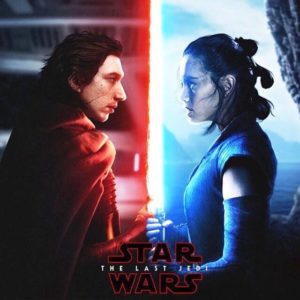 So now we’re getting to the heart of protecting what I love. Maybe I could have gotten behind the new movies if they had treated the source material with respect, and honored its legacy by being the next step in original and artistic movie making. But if they’re going to step on the story that made this franchise what it was, use it to launch a marketing scheme, and put out formula movies that have met a checklist of elements to include but haven’t crafted a well-written narrative, I just can’t. I, personally, cannot, no matter how hopeful and true some of its themes might be.
So now we’re getting to the heart of protecting what I love. Maybe I could have gotten behind the new movies if they had treated the source material with respect, and honored its legacy by being the next step in original and artistic movie making. But if they’re going to step on the story that made this franchise what it was, use it to launch a marketing scheme, and put out formula movies that have met a checklist of elements to include but haven’t crafted a well-written narrative, I just can’t. I, personally, cannot, no matter how hopeful and true some of its themes might be.
This leads me to the portrayal of Luke dying as he watches two suns go down. You could read that in two ways.
1. It’s a beautiful homage to Luke’s most iconic imagery in the old movies.
2. It springs from Disney’s eagerness to own the Star Wars legend and assert their right to continue writing its story.
I’m sure you can guess which interpretation sprang to my mind, and I’m sure you can guess which finger I’d raise to represent my thoughts about it.
Yet, Disney doesn’t own the Luke Skywalker legend. And neither did George Lucas. You know who owns Star Wars and Luke?
Cinematic history.
Our culture.
Anyone who loved it and was affected by it owns it.
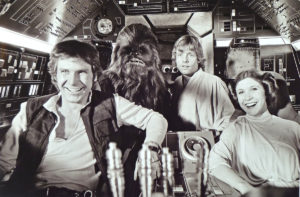 The biggest irony ever in this film is that Disney is the racehorse-beating casino owners, and the rest of us are the little kids with the broom for whom Luke’s legend transcends the limits anyone tries to put on it. Disney accidentally shamed itself in the very act of trying to establish ownership of the Star Wars universe. They can offer us their version of what happened to Luke, but if it doesn’t hit our Spidey-senses as fitting with his original narrative, then what is it other than a fun night at the movies?
The biggest irony ever in this film is that Disney is the racehorse-beating casino owners, and the rest of us are the little kids with the broom for whom Luke’s legend transcends the limits anyone tries to put on it. Disney accidentally shamed itself in the very act of trying to establish ownership of the Star Wars universe. They can offer us their version of what happened to Luke, but if it doesn’t hit our Spidey-senses as fitting with his original narrative, then what is it other than a fun night at the movies?
If you’ve made it this far, congratulations for not throwing something through your computer screen at my self-important crabby face. I feel like a cross between C3PO and a Spanish Inquisition zealout whenever this subject comes up, but also, I can’t help myself.
I just love OT Star Wars. I just love Han, Luke, Leia, the droids, Chewie, Darth Vader, the Emperor’s nasty face, and yes, even YOU Lando, you jerk.
I love everything those old movies are and were and will continue to be for generations of fans. I think this will be my last post about new Star Wars for a long time, because honestly, I want to turn my attention to appreciating what I love instead of mourning what I don’t like.
May the Force be with you.
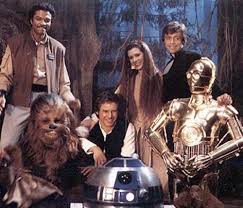

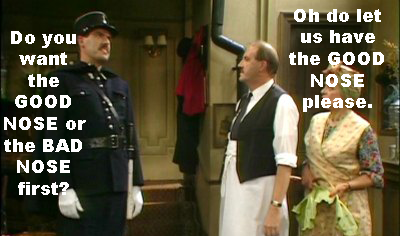

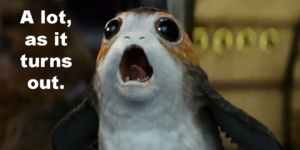
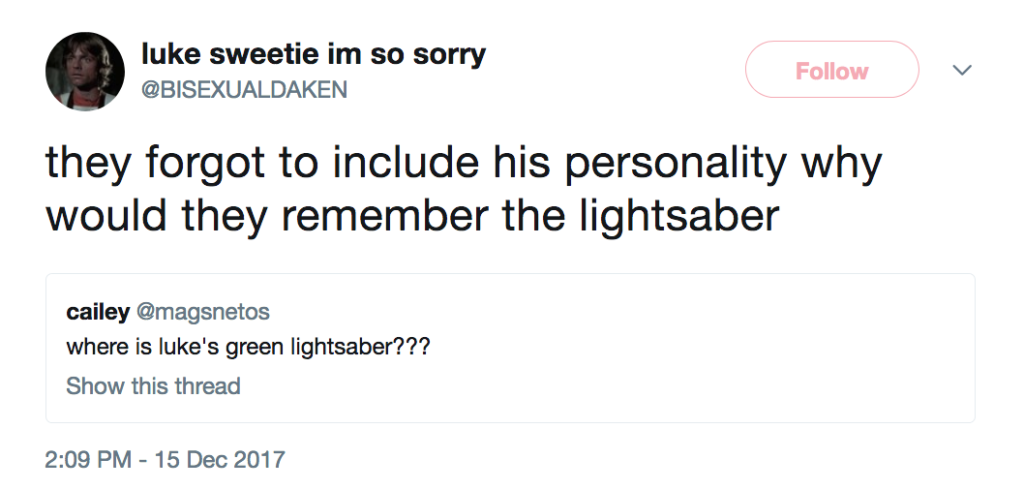
I have got to say I agree with a lot of what you have to say here. My wife and I saw TLJ last Sunday and I have say I was disappointed it seems Disney thinks they can spit fan service at us while simultaneously killing off Skywalkers one by one like this is bad 1980s horror film! If they were going to do this why didn’t they set these movies in the Knights of the Old Republic set 1000 years before the original Star Wars movies there is lots of room for new characters and they could spit a new movie out at us every couple of years without killing off the original cast which is surely what they plan on doing with Star Wars now that they have it. And if like me you as sick to death of crap Hollywood is shooting out at us as I am I would urge you to check out Star Wars Knights of the Old Republic books or audio books if like me you don’t have a lot of time for reading. I will link you one I recently listened to and plan on buying the rest of the series http://starwars.wikia.com/wiki/The_Old_Republic:_Fatal_Alliance This book follows one of my favorite Jedi from the SWTOR games Satele Shan grand master of the Jedi order and her Padawan Shigar Konshi I will send you link to the game intro cut-scenes so you can see her in action (the first 2 scenes contain her the rest do not) https://www.youtube.com/watch?v=RjG61DoDzN8 As you can see the fans have taken George Lucas cinematic universe and taken it in directions he never could of imagined I would encourage you to look past these cash grabbing movies and like Obi-wan said to Luke take your first step into a a larger world.
Thanks for the recommendation! I agree with you, there was so much potential for them to explore the larger universe instead of just trying to mangle the original story we already had! Thanks for the comment!